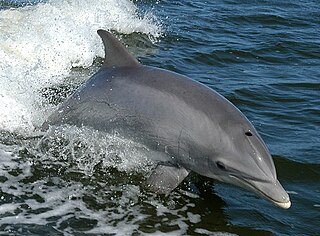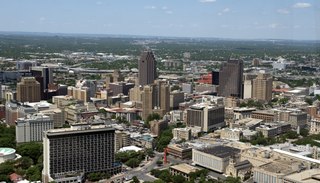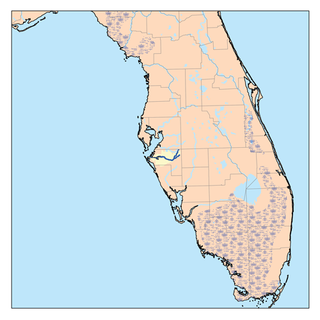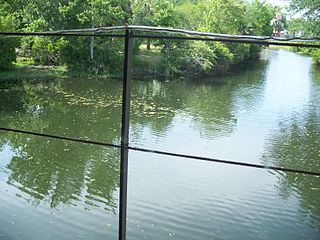
A dolphin is an aquatic mammal within the infraorder Cetacea. Dolphin species belong to the families Delphinidae, Platanistidae, Iniidae, Pontoporiidae, and possibly extinct Lipotidae. There are 40 extant species named as dolphins.

Marine mammals are mammals that rely on marine (saltwater) ecosystems for their existence. They include animals such as cetaceans, pinnipeds, sirenians, sea otters and polar bears. They are an informal group, unified only by their reliance on marine environments for feeding and survival.

Bridge City is a city in Orange County, Texas, United States. It is 100 miles east of Houston, near the Gulf of Mexico. The population was 9,546 at the 2020 census. The town borders the Neches River and Cow Bayou. It is part of the Beaumont–Port Arthur Metropolitan Statistical Area. The area is mostly known for its association with the petroleum products (oil) industry.

The tiger shark is a species of ground shark, and the only extant member of the genus Galeocerdo and family Galeocerdonidae. It is a large macropredator, with females capable of attaining a length of over 5 m. Populations are found in many tropical and temperate waters, especially around central Pacific islands. Its name derives from the dark stripes down its body, which resemble a tiger's pattern, but fade as the shark matures.

Bottlenose dolphins are aquatic mammals in the genus Tursiops. They are common, cosmopolitan members of the family Delphinidae, the family of oceanic dolphins. Molecular studies show the genus contains three species: the common bottlenose dolphin, the Indo-Pacific bottlenose dolphin, and Tamanend's bottlenose dolphin. Others, like the Burrunan dolphin, may be alternately considered their own species or be subspecies of T. aduncus. Bottlenose dolphins inhabit warm and temperate seas worldwide, being found everywhere except for the Arctic and Antarctic Circle regions. Their name derives from the Latin tursio (dolphin) and truncatus for the truncated teeth.

The National Aquarium – also known as National Aquarium in Baltimore and formerly known as Baltimore Aquarium – is a non-profit public aquarium located at 501 East Pratt Street on Pier 3 in the Inner Harbor area of downtown Baltimore, Maryland in the United States. Constructed during a period of urban renewal in Baltimore, the aquarium opened on August 8, 1981. The aquarium has an annual attendance of 1.5 million visitors and is the largest tourism attraction in the State of Maryland. The aquarium holds more than 2,200,000 US gallons (8,300,000 L) of water, and has more than 17,000 specimens representing over 750 species. The National Aquarium's mission is to inspire conservation of the world's aquatic treasures. The aquarium's stated vision is to confront pressing issues facing global aquatic habitats through pioneering science, conservation, and educational programming.

The Indo-Pacific bottlenose dolphin is a species of bottlenose dolphin. This dolphin grows to 2.6 m (8.5 ft) long, and weighs up to 230 kg (510 lb). It lives in the waters around India, northern Australia, South China, the Red Sea, and the eastern coast of Africa. Its back is dark grey and its belly is lighter grey or nearly white with grey spots.

The common bottlenose dolphin or Atlantic bottlenose dolphin is one of three species of bottlenose dolphin in the genus Tursiops. The common bottlenose dolphin is a very familiar dolphin due to the wide exposure it receives in captivity in marine parks and dolphinariums, and in movies and television programs. Spending their entire life in water, common bottlenose dolphins inhabit temperate and tropical oceans throughout the world, absent only from polar waters. While formerly known simply as the bottlenose dolphin, this term is now applied to the genus Tursiops as a whole. As considerable genetic variation has been described within this species, even between neighboring populations, many experts think additional species may be recognized.

South Texas is a region of the U.S. state of Texas that lies roughly south of—and includes—San Antonio. The southern and western boundary is the Rio Grande, and to the east it is the Gulf of Mexico. The population of this region is about 4.96 million according to the 2017 census estimates. The southern portion of this region is often referred to as the Rio Grande Valley. The eastern portion along the Gulf of Mexico is also referred to as the Coastal Bend.

Buffalo Bayou is a slow-moving body of water which flows through Houston in Harris County, Texas. Formed 18,000 years ago, it has its source in the prairie surrounding Katy, Fort Bend County, and flows approximately 53 miles (85 km) east through the Houston Ship Channel into Galveston Bay and the Gulf of Mexico. In addition to drainage water impounded and released by the Addicks and Barker reservoirs, the bayou is fed by natural springs, surface runoff, and several significant tributary bayous, including White Oak Bayou, Greens Bayou, and Brays Bayou. Additionally, Buffalo Bayou is considered a tidal river downstream of a point 440 yards (400 m) west of the Shepherd Drive bridge in west-central Houston.

The Manatee River is a 36-mile-long (58 km) river in Manatee County, Florida. The river forms in the northeastern corner of Manatee County and flows into the Gulf of Mexico at the southern edge of Tampa Bay.

The Texas State Aquarium is a nonprofit aquarium located in Corpus Christi, Texas, United States. It aims to promote environmental conservation and rehabilitation of the wildlife of the Gulf of Mexico. It has been accredited by the Association of Zoos and Aquariums (AZA) since 1995. It is the largest aquarium in Texas and one of the largest aquaria in the United States.

Six Flags Discovery Kingdom is a 135-acre (55 ha) animal theme park located in Vallejo, California, off of Interstate 80 between San Francisco and Sacramento. The park includes a variety of roller coasters and other amusement rides. Six Flags Discovery Kingdom has been part of the Six Flags chain of amusement parks since 1999.

East Matagorda Bay is a bay off Matagorda County on the Texas Gulf Coast, enclosed by the Matagorda Peninsula and the tidal flats at the mouth of the Colorado River. It is a minor estuary, one of a series of estuaries along the Gulf Coast of Texas, but it has no significant river sources, receiving only the runoff from the adjacent coastal watershed. Its only true opening to the Gulf of Mexico is through Brown Cedar Cut, near the north end of the peninsula. East Matagorda Bay was devastated by the 1942 Matagorda Hurricane, the most devastating hurricane of the 1942 Atlantic hurricane season.

Homosassa River is a 7.7-mile-long (12.4 km) river in Citrus County, Florida, in the western part of the state. Its headwaters are the Homosassa Springs, and from there it flows west into the Gulf of Mexico. The river is home to common bottlenose dolphins, West Indian manatees, alligator snapping turtles, nine-banded armadillos, snakes, birds, eastern box turtles, oysters, raccoons, American alligators, Virginia opossums, North American river otters and many species of both freshwater and saltwater fish. The Homosassa River is an estuary, which means that as it moves inland, it changes from salt water to fresh very gradually, and the river is brackish. The river is good for canoeing and kayaking.
Deadly... is a strand of British wildlife documentary programming aimed principally at children and young people, which is broadcast on CBBC on BBC One and Two and on the CBBC Channel. It is presented by Steve Backshall, with Naomi Wilkinson as co-host on Live 'n Deadly, and Barney Harwood as co-host on Natural Born Hunters. The strand began with a single series known as Deadly 60, and has subsequently expanded into a number of spin-offs, re-edits and follow-up versions.

Clearwater Marine Aquarium is a 501(c)(3) non-profit organization, and aquarium in Clearwater, Florida. It is dedicated to the rescue, rehabilitation and release of sick and injured marine animals, public education, conservation, and research.

The fauna of the United States Virgin Islands consists of 144 species of birds, 22 species of mammals, 302 species of fish and 7 species of amphibians. The wildlife of the U.S.V.I. includes numerous endemic species of tropical birds, fish, and land reptiles as well as sea mammals. The only endemic land mammals are six species of native bats: the greater bulldog bat, Antillean fruit-eating bat, red fruit bat, Brazilian free-tailed bat, velvety free-tailed bat and the Jamaican fruit bat. Some of the nonnative land mammals roaming the islands are the white-tailed deer, small Asian mongoose, goats, feral donkeys, rats, mice, sheep, hogs, dogs and cats.

Christmas Bay is a small bay located on the Texas Gulf Coast in Brazoria County, Texas, immediately southwest of West Bay, near the Galveston Bay system's southwest corner. It is a minor estuary, one of a series of estuaries along the Gulf Coast of Texas, and receives the discharge from Bastrop Bayou, along with the adjacent coastal watershed. The bay is separated from the Gulf of Mexico by Follet's Island and connects with it through San Luis Pass and Cold Pass. Its minor extensions are Bastrop Bay to the north and Drum Bay to the southwest. The nearest city is Freeport, about 10 miles (16 km) to the southwest at the mouth of the Brazos River.

The Acuario de Veracruz is a public aquarium located in the city of Veracruz. It is the biggest aquarium in Mexico and Latin America by water volume, with 7 million liters of water.


























